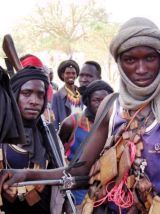Darfur’s once-united rebels are now fighting each other
By Shashank Bengali
July 10, 2006 (TAWILLA) — The attack on the village of Tarny was a textbook Darfur killing spree: Gunmen, riding on horses and in SUVs, swarmed in before dawn, looting livestock and shooting villagers.
 The only difference: These gunmen weren’t the fearsome Arab militiamen known as the janjaweed. The janjaweed have been blamed for killing tens of thousands of black villagers in Sudan’s remote west in a three-year campaign that the United States has called genocide.
The only difference: These gunmen weren’t the fearsome Arab militiamen known as the janjaweed. The janjaweed have been blamed for killing tens of thousands of black villagers in Sudan’s remote west in a three-year campaign that the United States has called genocide.
Instead, villagers said, the men who raided Tarny last month were members of the rebel movement that used to protect them from the janjaweed.
Deeply divided over a controversial peace agreement to end the war here, the rebels have turned on each other – and against the civilians they once claimed to protect.
In the past week, U.N. and African Union officials have reported clashes between rebels in more than a dozen villages and towns in northern Darfur. About 4,000 civilians have fled the latest fighting, and there have been scattered reports of murders and rapes. U.N. officers said they hear troubling echoes of the janjaweed attacks that ripped open the Darfur conflict in 2003.
“That is the order of the day – the killing and violence and planned operations are coming not from the janjaweed, but from within the rebel movements,” said Col. Richard Lourens. Lourens is the commander of the African Union troops monitoring the two-month-old peace agreement and based in the town of Kutum, in northern Darfur.
The rebel movement, known as the Sudan Liberation Army, has been riven by political disputes since its founding in 2002. But the split has grown wider since one faction agreed to sign a May 5 peace accord.
That faction, led by military commander Minni Minawi, is behind the attacks. It’s an effort to drive out anyone loyal to Abdol Wahid al Nur, a movement founder who rejected the peace deal.
Minawi is a member of the small but well-armed Zaghawa tribe. Nur is from the dominant Fur tribe.
The conflict is exacerbated by changing loyalties. Some of Minawi’s field commanders have defected, and analysts say the troubled commander is trying to reassert control over Darfur’s fractured terrain.
Nur enjoys more public support but is seen as a detached and ineffectual leader. His commanders also are jumping ship to form new coalitions.
Most of the fighting has occurred in villages held by the Fur, who comprise most of the newly displaced people, according to U.N. reports.
With alliances shifting like sands in a dust storm, Darfur is more divided than ever. Villages such as Tarny, once thought to be safe under rebel protection, are again battlegrounds, and tribes that have coexisted in this restive region for centuries now see each other as adversaries.
The mounting violence has made a mockery of a peace deal that the Bush administration and other international observers hailed at the time as a diplomatic breakthrough. The deal is broadly unpopular in Darfur, analysts said.
It gives the Sudanese government a pretext for not disarming the janjaweed, the first and most contentious step in implementing peace, said Jemera Rone, a Sudan expert with Human Rights Watch.
“It complicates things enormously,” Rone said. “I don’t see how the government is going to proceed with disarming the janjaweed when there are still people out there who have not agreed to disarm and who are still fighting.”
For Darfur’s people, it’s the latest miserable twist to a conflict that’s killed some 200,000 people and forced 2.4 million from their homes.
Two years ago the janjaweed raided Tarny, a Fur village. It wasn’t until rebels retook the area last year that villagers thought it safe to return.
Now they’re homeless again.
“First, we run from the janjaweed. Now the SLA (rebels),” said a bewildered Haja Saleh, 43, who lost a small fortune in the June 29 attack on Tarny – a camel, two donkeys and 18 goats.
But she was fortunate to escape with her life. While fleeing on foot with seven children in tow, she saw two men lying face down in the sand, shot dead by their assailants.
Now Saleh and other villagers are huddled on the outskirts of a camp for displaced people near the northern market town of Tawilla, some 20 miles across sandy plains from Tarny. They managed to hang onto few possessions – gardening tools, jerrycans to hold water, the clothes on their backs.
Saleh, an outspoken woman with an angular coppery face, said she had no doubt why Tarny was targeted. “It was the Zaghawa,” she said. “They attacked us because we are Fur. They think we belong to Abdolwahid.”
A short distance away, in Tawilla’s market, tensions between Fur and Zaghawa are latent. In a recent meeting with a visiting journalist, a group of Fur townspeople sitting at a tin-roofed cafe openly decried the attacks in the area. But questions about who perpetrated the violence were met with only nervous stares.
Abdelraheem, an aging rebel commander from the smaller Justice and Equality Movement, which once fought alongside the SLA on behalf of Darfur, lamented the seemingly irreparable schism of former allies.
“When the rebel movement was still one, we had one goal, and we proceeded toward that goal,” Raheim said. “Now everyone is after his own interests, not the people’s.”
(KRT)
